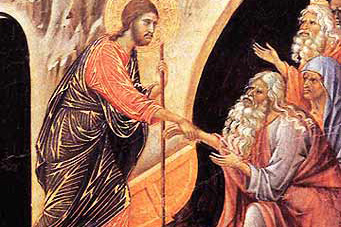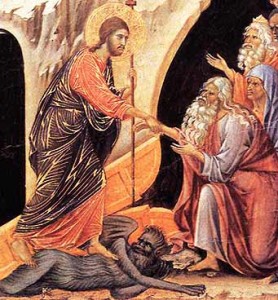Where is Christ after he dies on Friday afternoon and before he rises on Easter Sunday? Both Scripture and Tradition answer this question. Consider the following from a Second Century Sermon and also a mediation from the Catechism of the Catholic Church.
An Ancient Sermon:
Today a great silence reigns on earth, a great silence and a great stillness. A great silence because the King is asleep. The earth trembled and is still because God has fallen asleep in the flesh and he has raised up all who have slept ever since the world began. . . He has gone to search for Adam, our first father, as for a lost sheep. Greatly desiring to visit those who live in darkness and in the shadow of death, he has gone to free from sorrow Adam in his bonds and Eve, captive with him – He who is both their God and the son of Eve. . . “I am your God, who for your sake have become your son. . . I order you, O sleeper, to awake. I did not create you to be a prisoner in hell. Rise from the dead, for I am the life of the dead.” [From an Ancient Holy Saturday Homily ca 2nd Century]
Nothing could be more beautiful than that line addressed to Adam and Eve: I am your God, who, for your sake, became your Son.”
Scripture also testifies to Christ’s descent to the dead and what he did: For Christ also suffered once for sins, the righteous for the unrighteous, that he might bring us to God, being put to death in the flesh but made alive in the spirit, in which he went and proclaimed to the spirits in prison….For this is why the gospel was preached even to those who are dead, that though judged in the flesh the way people are, they might live in the spirit the way God does. (1 Peter 3:18; 1 Peter 4:6).
Consider also this from the Catechism on Christ’s descent to the dead, which I summarize and excerpt from CCC # 631-635
[The] first meaning given in the apostolic preaching to Christ’s descent into hell [is] that Jesus, like all men, experienced death and in his soul joined the others in the realm of the dead.
But he descended there as Savior, proclaiming the Good News to the spirits imprisoned there [1 Peter 3:18-19; 1 Peter 4:6; Heb. 13:20]. Scripture calls [this] abode of the dead, to which the dead Christ went down, “hell” – Sheol in Hebrew, or Hades in Greek – because those who are there are deprived of the vision of God [1 Peter 3:18-19].
Such [was] the case for all the dead, whether evil or righteous, while they awaited the Redeemer: It is precisely these holy souls, who awaited their Savior …whom Christ the Lord delivered when he descended into hell.”[cf Psalms 89:49; 1 Sam. 28:19; Ezek 32:17ff; Luke 16:22-26]
Jesus did not descend into hell to deliver the damned, nor to destroy the hell of damnation, but to free the just who had gone before him.
[So] the gospel was preached even to the dead. The descent into hell brings the Gospel message of salvation to complete fulfillment. This is the last phase of Jesus’ messianic mission, a phase which is condensed in time but vast in its real significance: the spread of Christ’s redemptive work to all men of all times and all places, for all who are saved have been made sharers in the redemption.
Christ went down into the depths of death so that “the dead will hear the voice of the Son of God, and those who hear will live.”[1 Peter 4:6] Jesus, “the Author of life”, by dying, destroyed “him who has the power of death, that is, the devil, and [delivered] all those who through fear of death were subject to lifelong bondage” [John 5:25; Mt 12:40; Rom 10:7; Eph 4:9].
Henceforth the risen Christ holds “the keys of Death and Hades”, so that “at the name of Jesus every knee should bow, in heaven and on earth and under the earth.”[Heb 2:14-15; Acts 3:15]
Here is a link to my recorded sermon on this topic: Where is Jesus Now



This was so good. I have always felt, that when He uttered the “It is finished” that Hell screamed in agony, as He stood before those accursed gates, shining like the sun and let them witness His Victory, leading those faithful who had so long awaited him-Home. With Father Adam and Mother Eve holding His beloved hands.
After all these years as a Christian, I had a revelation watching the video, and then went back and read the blog again. It became so clear and evident.
All my life I wondered how our just God could let people from the dawn of the ages die without having a chance to know Him; without knowing his son Jesus Christ, without ever hearing the gospel. Mind you, I’m not a new Christian, but there always remains difficult questions with even more difficult answers. And then I realized, Jesus decended into hell for the sake of those who were already dead going back to the days of Noah, to deliver to them the good news, offering the same gift of salvation we have available to us today!
I can’t tell you how much this helps my journey with the Lord. It’s almost as if my eyes have been reopened to something I’ve never seen.
Thank you Holy Spirit!
The mystery of eternity.
On this day, Jesus lies dead in the tomb. And yet, He does not “rest in peace.”
Jesus is not resting, but working, even though dead, just as the saints to do “rest in peace,” but continue to serve. Rather, this day, as He lies dead in the tomb, the Eternal One is also preaching the Gospel to those who have gone before. Not so much two places at once as two times at once, just as His death and resurrection are happening for us right now.
Hey Bender, Good to hear from you. It’s been a while!
The Busted Halo Show, on The Catholic Channel on Sirius XM, interviewed a Protestant gentleman who recently wrote a Lenten reflection book. The key point he was talking about, the true sadness of sin as he put it, was that when Jesus died for our sin, the rest of Good Friday and all Holy Saturday, He was separated from God the Father. I don’t know if he meant literally the hypo static union was split for this time or not, but Catholics don’t believe that right?
The hypostatic union union refers to the union between the two natures of Christ: Divine and Human. The beatific vision refers to Christ’s Human nature and its union with and vision of God the Father and at no time did he lack this vision, though it is a mystery how he could suffer on the cross and still have it. Finally, since there is only one divine nature, at no time could Christ, in his divine nature be separated from his Father or the Holy Spirit.
When Adam fell–and with him Eve–we all fell. Adam went, with his Fall, from being our champion to just being another face in the crowd. So, when Adam and Eve made it to heaven-because Adam is no longer our champion-that is NO guarantee that we will make it to heaven. Nonetheless, Adam and Eve are still our first earthly parents, and since it is undisputed that they made it to heaven, all of us can say that we have good parents. Maybe the children of divorced parents can take some encouragement and consolation from that.
In a strict sense, the question “Where was Jesus?” has an unambiguous answer: He was in the tomb. “Place” is an accident pertaining to the Body, and His Body lay in the Holy Sepulcher.
This may sound like nit-picking, but it’s just as well to remember that we use corporeal-sounding language to describe spirits simply because our imagination leaves us no choice. It’s no problem as long as we remember it’s just a figure of speech, but any awareness of modern TV shows that many people — probably a majority — can no longer distinguish a spirit from a corporeal phenomenon they cannot understand, such as electromagnetism.
Even more importantly, we need to remember that the Divinity of Jesus was not separated from His Body at death. That possibility has simply never crossed my mind when I was a Protestant; without thinking about it, I had always assumed that the Divinity of Jesus was really united only with His human soul.
Wonderful post Msgr. Pope…Thank you.
I hope everyone has a joyous Easter.
Great insights – and great blog. Thanks!